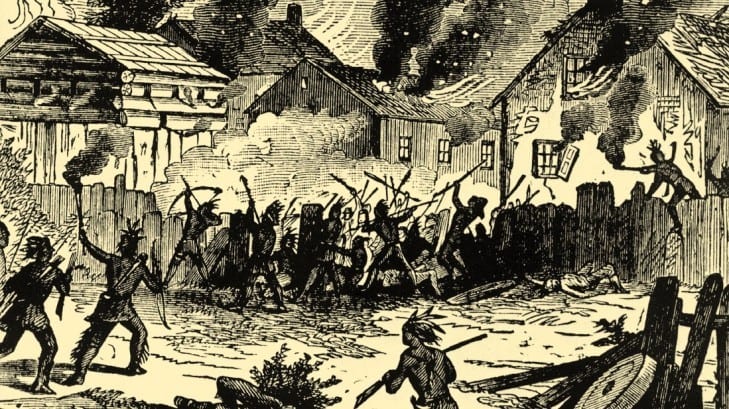
November 23, 2015
BY JASON PRAMAS @JASONPRAMAS
The following passage is excerpted from a piece I wrote in 2005. It recounts the story of King Philip’s War—which was fought across southern New England 340 years ago, and started not far from where I attended a Thanksgiving dinner that year at my cousin’s place in North Attleborough. Read it. Think about it. Discuss it with friends and family. And, if you can make it, join the United American Indians of New England and allies for a day of remembrance and protest at the 46th National Day of Mourning on November 26 at noon at Coles Hill in Plymouth. Get all the information, and a more accurate version of the history of “Thanksgiving” at the UAINE website.
In 1675, a Wampanoag sachem named Metacomet (or King Philip to the English) launched—somewhat reluctantly—a war against English colonists in what is now Massachusetts that came closer than any other war launched by America’s native peoples to ending European domination in at least one corner of the “New World.” It was the last colonial war in which the two sides had relatively equal numbers, and used basically equivalent technology.
Had not disease already decimated the native population of the area decades before, the English never could have won.
The grievances of the faction of the Wampanoags that began the war—and the other nations that joined them including the Narragansetts, Pocumtucks, and Nipmucks—were fairly straightforward. The English unceasingly attempted by foul means and fair to convert the native nations to Christianity. And they continually overstepped the bounds of various treaties and contracts with native peoples in taking land that wasn’t theirs for their own exclusive use.
Two years later, roughly 800 colonists and 6000 Native Americans were dead. Dozens of towns and settlements on both sides were wholly or substantially destroyed. Atrocities were committed by all parties to the conflict—though the English outdid their opposition in that respect, unsurprisingly.
Most of the fighting took place in what are now Plymouth and Bristol Counties in southeastern Massachusetts, in much of Rhode Island, and in the Connecticut River Valley in both western Massachusetts and Connecticut—but it raged throughout modern day New England, and smouldered on for over 100 years with no official end date marked. No treaty, broken or otherwise, was ever signed by either side.
A number of Native American nations were for all intents and purposes destroyed—at least as political entities. The rest were assimilated or marginalized.
The war forever cast Native Americans into the role of “savages”—a subhuman status fit only for subjugation or extermination. For 300 years after the war, most American historians gave short shrift to native justifications for the conflict, and exulted in the glory of a holy war won against the forces of darkness.
After you absorb that Native American history, I recommend you delve into some local Black history that activists at Harvard Law School have unearthed. It seems the school was founded with money from a vile family of slavers by the name of Royall. Making matters worse, Harvard Law then adopted the Royall family coat of arms as its crest. The protesters are calling for the decolonization of their campus, the symbols, the curriculum and the history of Harvard Law School. Readers can find out more by following #RoyallMustFall on Twitter and Facebook.
And a big shout out to the #ConcernedStudents2015 student activists at Brandeis University occupying their administration building for racial justice on their campus as we go to press. Stay strong!
Apparent Horizon is syndicated by the Boston Institute for Nonprofit Journalism. Jason Pramas is BINJ’s network director.
Copyright 2015 Jason Pramas. Licensed for use by the Boston Institute for Nonprofit Journalism and media outlets in its network.